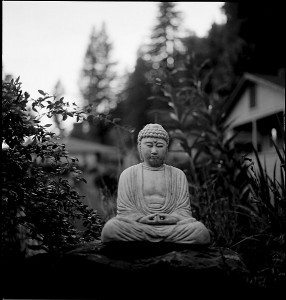At some point, all writers confront writer’s block. Many methods exist to help you unleash your creative thinking, some even created by published authors or famous writing teachers.
These exercises for stimulating creative thinking can sometimes help you break free of the blank page (or a computer screen filled with babbling nonsense), but they often feel like exactly that—exercises.
Meditation offers a well-traveled path for finding balance, which in turn improves creativity. This, along with the other benefits of meditation, makes it an excellent resource for your writer’s toolbox.
In order to learn how to use your creative thinking more consistently, you need to move beyond the blocks that prevent you from connecting with the world around you. As Pico Iyer says in Lion’s Roar magazine, when you write “you take something that might only have been heartache and turn it into something more provocative, enriching, and even instructive.”
Ultimately, writing comes from observing your world. Writers are channels for sensory experiences, distilling each sight and sound into its essential essence, and capturing it in words on a page.
Creative Thinking By Stripping Away the “Noise”
At its heart, meditation involves stripping away the layers of “noise” that keep you from seeing the world clearly. This includes things like anxiety, confusion, and rambling thoughts. Like the layers of an onion—or caked-on mud, if you are feeling particularly dark—these can be removed, one layer at a time, through meditation.
After all of the layers are gone, what is left is your own essential essence, what Buddhists refer to as your “Buddha nature.” This is pure and true. Most importantly, though, when your mind is still, you can experience the world without the chattering of your mind getting in the way. It’s like polishing the lens of a telescope so you can look at the stars instead of the bits of dirt stuck to the glass.
Meditation as a Path to Creative Thinking
 Meditation is not easy, but it’s not particularly hard, either. If you are a writer, you already spend much time inside your own mind, so you should already be familiar with the dark corners of that inner landscape. The most difficult part will be turning off the discursive writer’s mind that narrates much of your day.
Meditation is not easy, but it’s not particularly hard, either. If you are a writer, you already spend much time inside your own mind, so you should already be familiar with the dark corners of that inner landscape. The most difficult part will be turning off the discursive writer’s mind that narrates much of your day.
There are many meditation techniques that can help writers become more creative. Mindfulness meditation, though, is a particularly useful tool. Its purpose is to train you to pay close attention to what you are doing and what is going on around you. This, of course, is what writer’s do.
Learning to unleash your creative thinking with meditation may take time. Changes are often small, but over time, you will find yourself less daunted by a blank page. You may also notice that, as you watch the world mindfully, you will more easily replenish your mental stores of characters, settings, and stories.
Over the next two posts, I will outline a writing process to help you unleash your creative thinking with meditation. The first part involves finding stillness within your own mind. Before you work with meditation and writing together, you need to be able to sit quietly for a few moments.
After you have stripped off a few of your mind’s noisy layers, you can start to expand outward. In the second part, you will learn how to observe the world mindfully, and then write from within that stillness. By coming from this place of peacefulness, you will be able write more easily, in what some people call flow.
__________
Photo: © Dennis Mojado.


